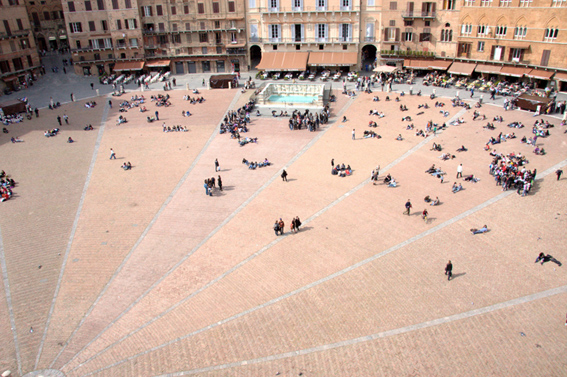
We ventured out to explore Siena with Lynn Catterson and just in the midst of our tour stopped at the Piazza del Campo to watch the people and the world go by. The Sienese Duomo resembles a delicious pastel cake, but black and white marble also used in alternating stripes is etiologically linked to the symbolic colours of Siena and the black and white horses of the legendary city’s founders, Senius and Aschius. The cathedral is unique also in that its axis runs north south like a Latin cross with a slightly projecting transept. The reason for this may be the overly ambitious plan of building the largest cathedral then in existence, which was abandoned after completion of the east wall when the money ran out and Black Death came.
The main facade of the cathedral was finished in 1380, and we stood to admire it long before we went inside, but the interior hides the famous octagonal pulpit made by Nicola Pisano in 13th century with scenes exploring the theme of Salvation and the seven scenes which depict the Life of Christ. All the while one might accidentally step on the inlaid marble mosaic floor and find oneself in the gorgeous kaleidoscope of graffito mosaics: 56 panels depicting sibyls as allegories and virtues from the Old Testament. The baptistry beneath the Duomo offers plenty of the 15th Century sculpting gems, such as the hexagonal baptismal font with bas-reliefs and gilded brass figures by Donatello, Ghiberti, and Jacopo della Quercia, representing the Life of the John the Baptist.
‘The Feast of Herod’ by Donatello, sculptures of Saint Peter, Saint Paul, Saint Gregory and Saint Pius by young Michelangelo, Madonna and the Child which seems to be della Quercia’s work, not to mention Duccio’s Maesta and the Cimabue stained glass window, which have been moved to the museum, build up a deep desire to spend days in this town’s Cathedral and not only an afternoon for a general tour.
The art of Siena had a characteristic style, one that can be apprehended through a comparison between Duccio, Martini, Lorenzetti, di Bartolomeo and Florentine artists.
There are, however, sights whose significance transcends the particularities of Siennese craft. Underneath the cathedral, in a room where the real facade sculptures are stored for display, on the tile floor of this basement, sometimes hidden by the statives holding sculptures, at other times actually simply destroyed on account of what seems more like negligence than the passing of time, visitors may still see a series of mosaics representing the seven ages of man: Infantitia, Pueritia, Adolescentia, Juventus Virilitas, Senectutes and the most disparaged and worn out of the group, barely distinguishable – Decrepitas. The mention of the seven ages of man in Shakespeare’s As you Like it has bolstered claims that the Earl of Oxford, and not the man from Stratford, was the author of the plays, since the latter seems never to have travelled out of England.
The Seven Ages of Man might have charmed some of us, but this its effect paled in comparison to the spectacular interest students showed in the frescoes of Palazzo Publico, the most famous secular frescoes in a series on government in the Hall of the Nine by Ambrogio Lorenzetti. The Bad Government wall has been badly damaged, to say the least. Apparently the city government kept its salt stores (salt used to be a state monopoly) in the room underneath. Salt was piled up against the same wall, and mixed with moisture it seeped up through the wall, destroying large parts of the fresco. Good Government is located on the main wall across the windows, and this location is chosen by Lorenzetti so that it could be better illuminated, and thus more easily seen by visitors. On the lower level Concordance and members of the city council reside. On the upper level, the genius of Wisdom is floating before a blue background with book and large scales in his hands while Justice, who sits on a throne on the middle level, balances the sales. We also see the prosperous and safe home with pets and plants in windows, women dancing gracefully in a circle, men hunting and life’s pleasures assured juxtaposed with an image of a poor man with a hat in his hand, begging.
Charity and prosperity go together hand in hand, it seems, as did we, hurrying to catch the last bus to Florence, savoring cherished moments spent near the masterpieces.
By Ena Marija Gojak (’09, Croatia)
